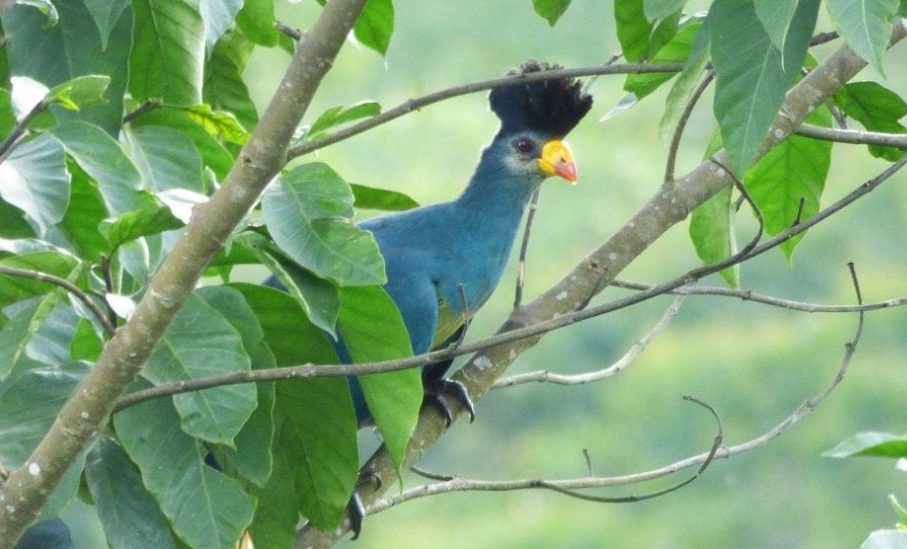
According to Roussouw, “Kibale Forest harbours the greatest variety and concentration of primates found anywhere in East Africa.”
Well, thumbs up to that. Kibale is where the muzungu saw her first wild Chimpanzee, and the apparently ‘elusive’ Red Colobus monkey (although I’m not sure whether the staff at Kibale Forest Camp would agree, hearing them crash through the forest while they’re serving the guests sundowners).
Incredibly rich in animal life, Kibale is a place of many firsts for me. Even after three years in Uganda working in conservation, Mother Nature’s still been holding back on me: my first wild chimp, my first Red Colobus Monkey, my first Green Mamba! But these were all unexpected bonuses – we’d actually travelled to Kibale to ring birds.

The previous day Julia had instructed the boys to hack a pathway through the high grass at the edge of the forest. Four-metre high bamboo poles were hung with a fine nylon ‘mist net’ barely visible at dusk or dawn, gently ensnaring unsuspecting birds. Off with the anoraks and on with the Ipod – there’s as much technology in 21st-century birding as in any walk of life . (Bird calls are stored on the iPod, which is hung strategically close to the forest to attract the birds). Every few minutes, one of the team would disappear into the Bush to check the net, returning excitedly a few minutes later with their feathered booty in a little cloth bag.

On our feet since dawn, ringing birds is harder than it looks: concentrating on the welfare of the birds, not leaving them in the net for more than 20 minutes, keeping them cool.
No-one had slept much the night before. We’d been woken at two in the morning by a gargantuan face-off between the chimps in the forest and three dogs tearing around the compound – all set off by a hungry elephant! It was the chimps that had woken Mandela. He’d then quickly woken Bahati and off they ran to chase the elephants away from the precious pineapple field.
That morning, expert birder and tour guide Malcolm was very excited at rumours of a White Collared Oliveback – “Ooooh, put it back in the bag,” he said, savouring the moment.
Dawn looked nervous when advised she was about to pull ‘a new bird’ out of the bag. It’s a bit like lucky dip really! Or not so lucky in Dawn’s case: she dipped her hand in – and winced in agony as an enormous beak bit her hand! The Blue Breasted Kingfisher was one of the weekend’s top finds, with the most experienced ringer ‘getting the tick first.’ If there was envy, no-one let on!

Malcolm gave Dawn more warning about the Grosbeak (Thickbilled) Weaver: “Beware Dawn, this one has an 80 pound per square inch peck!” i.e. don’t be fooled by the small beak, it can exert a painfully powerful peck!

“The secret is to get the kids involved” said Richard, encouraging Hope and Amos to hold the birds and help identify them. He was less positive about the Marsh Tchagra: “they bite a lot, like all Shrikes – nasty birds.”

Eager to see the birds in the nets (before anyone else!) – I got lost – twice!
Malcolm waved his finger at me sternly as Nathan and I rejoined the group back in the shade by the house.
“Don’t spend so much time by the nets,” he said. I felt embarrassed. (I didn’t mean to get lost!)
Highlights of the two days’ ringing included a pair of exquisite Grey-headed Negrofinches (now known as Negritas), Green-backed Twinspots, a Little Greenbul (I was relieved to hear the experts struggle to identify birds too!) and a Brown-chested Alethe (a species of forest thrush that can only be caught with an iPod and a mist net); a Green Hylia (a type of warbler), an Olive-bellied Sunbird and a tiny White-ringed Prinia.
You can read a full trip report from the visiting birders on the Teifi Ringing Group’s blog.

It was a real treat for an amateur birder like me to see such wonderful birdlife come out of the forest. Everyone pointed out birds flying overhead and in trees around us: an emerald green Diederick’s Cuckoo, Lesser Striped Swallows, African Grey parrots, a Superb Sunbird; a Black Crowned Tchagra (a shrike) in the long grass.
The Roussouw guide says “watch for flocks of rare and localised White Naped Pigeons in-flight overhead or sunning themselves in treetops in the early morning” and lo and behold, the White Naped Pigeons were in front of us.
Fascinating and fun too, the two days’ information collected is baseline data for a study of the biodiversity of the forest edge. The data’s being shared with NatureUganda, one of the partners in a new East African bird ringing scheme.

- African Blue Flycatcher
- African Grey Parrots
- African Yellow Whiteye (R)
- Black Crowned Tchagra
- Blue Breasted Kingfisher (R)
- Bronze Mannikin
- Bronze Sunbird
- Brown-chested Alethe (R)
- Brown-throated Wattle-eye
- Diederick’s Cuckoo
- Dusky Blue Flycatcher
- Green Crombec (R)
- Green Hylia (R)
- Green Twinspot (R)
- Green-backed Twinspots (R)
- Grey-backed Camaroptera (R)
- Grey-headed Negrofinch (R)
- Grosbeak (Thick-billed) Weaver (R)
- Klaas’s Cuckoo (R)
- Lesser Striped Swallow
- Little Greenbul (R)
- Marsh Tchagra (R)
- Northern Double-collared Sunbird
- Olive-bellied Sunbird (R)
- Pygmy Kingfisher (R)
- Ross’s Turaco
- Slender-billed Weaver (R)
- Snowy-headed Robinchat (R)
- Superb Sunbird
- Vieillot’s Black Weaver
- White-naped Pigeon
- White-collared Oliveback (R)
- White Chinned Prinia (R)
- White-headed Sawwing
- Yellow-rumped Tinkerbird (R)
- Yellow-whiskered Greenbul (R)
NOTE 2021: Since writing this blog, the 40 acres of regenerating farmland have developed into Sunbird Hill, a site for birders, ornithologists, lepidopterists, entomologists, primatologists and tourists who want to be immersed in nature. Sunbird Hill supports the work of In the Shadow of Chimpanzees, a small NGO that is training young people in conservation and developing village tourism along the edge of the National Park.


























Wow, Charlotte. Amazing stuff. It’s good to see we still have some nature left! Re the picture with you and the gorrillas on the home page – eh – which one is you? Hee hee! On On
Thanks for the appreciation lady! Oh yes ‘still plenty of nature left’ in Uganda but encroachment continues everywhere.
I don’t mind being compared to a gorilla. Far more attractive than many a Hasher I know! ON ON. Hope to come visit you in Dar Es Salaam eventually!
I never even knew we had so many birds until that time we were there. I only ever saw them on TV.
Hi Victoria, did you know Uganda has 50% of the whole continent’s species? it’s a birders’ dream 🙂 every habitat (Forest, Savannah, Lake, etc) has different kinds of birds. it’s best to go birding with a professional, you will see so many more birds. Every species is unique with its own distinctive song, flying pattern, mating behaviour, etc. I love birds!
You are one lucky lady my friend. To live and work in such an amazing and diverse country that you are. I so wish I was back there with you. The landscape and wildlife are truly amazing.
Hi Nik, thanks for your comment! indeed, Uganda truly is ‘gifted by nature’ – I wish more Ugandans realised how special this country is.I think many of them think we have elephants running around London / New York / wherever! having a herd of elephants invade your garden and destroy it isn’t a blessing, that’s for sure though.
I have a spare bedroom by the way – you’re always welcome 🙂
Loved the article and thanks for sending it. What a magical place and Julie’s hospitality was wonderful.Back to our LBJ’s (Little Brown job’s) meaning all our birds are SO brown it was such an experience seeing so many beautiful, colourful birds.
hello Dawn, thanks for the great feedback – I feel very lucky to have tagged along with you all that w/end. I learned so much about birding and Forest birds in particular – and I thought I’d seen quite a few birds already! Hopefully we’ll see you back in Uganda one day? We’re spoiled rotten here with colourful birds but I’m also a big fan of Britain’s David Lindo, the urban birder – a reminder that there is still wonderful birdlife in the UK. Have written an article for him – urban birding in Kampala, coming soon!
Nice and interesting blog 🙂
hi there thanks for dropping by. And thanks for the feedback. Feel free to sign up to my newsletter to get instant updates every time I post new content – usually once a week.
Dillon has just said his first word – and it was BIRD!
Cha. You are a beauty! I know you are actually quite pale and cannot fly (!) but even so it is as if you were one of the beautiful Ugandan birds yourself, introducing us to your feathered friends and the joyous pictures and experiences you bring to us in your blog are just terrific! I spotted a new duck on a lake “up river” from us this afternoon and thought of you naturally. It turnned out to be a male Tufted Duck, very striking and east to identify for a change! I thought your picture of that beautiful kingfisher actually above the page of the bird book was inspired! XXX
Dearest Pa, thanks for reliving the moment with me. It was such a treat to be with such knowledgeable people in such a beautiful part of the world. I have to pinch myself sometimes! makes me smile remembering it all 🙂 x x
great place, so much potential.
BTW, White-chinned Prinia and Duillion is eyeing up a Diderick Cuckoo, not a Klaas’s cuckoo.
Aiming to bring a bunch of Aussies there next year, just to give you time to prepare!!
Tx Malc, knew I’d get my green cuckoos confused! Will amend.
Looking forward to next year already. Must find a way to cool beer if Aussies coming…!
Spectacular Kingfisher…………..wow! What and amazing list of birds.
The birds in Uganda are incredible – 1,066 species discovered so far… to give you an idea of the difference between UK and Uganda, the UK has one type of kingfisher; Uganda has seven types! I love birds 🙂
Visit Kibale Forest – for not only Africa’s highest variety of primates but wonderful birdlife and incredible butterflies too, esp after the rains… bird watching on the edge of Kibale Forest is magic, you can hear and see birds you don’t see anywhere else.
Bird and breakfast accommodation is now available in Kanyanchu, a few minutes from the park gate. It’s perfect for people who plan to go chimping and then enjoy the birds. It’s an easy half an hour’s walk through the village to Bigodi Swamp as well. Just drop me an email for more info.